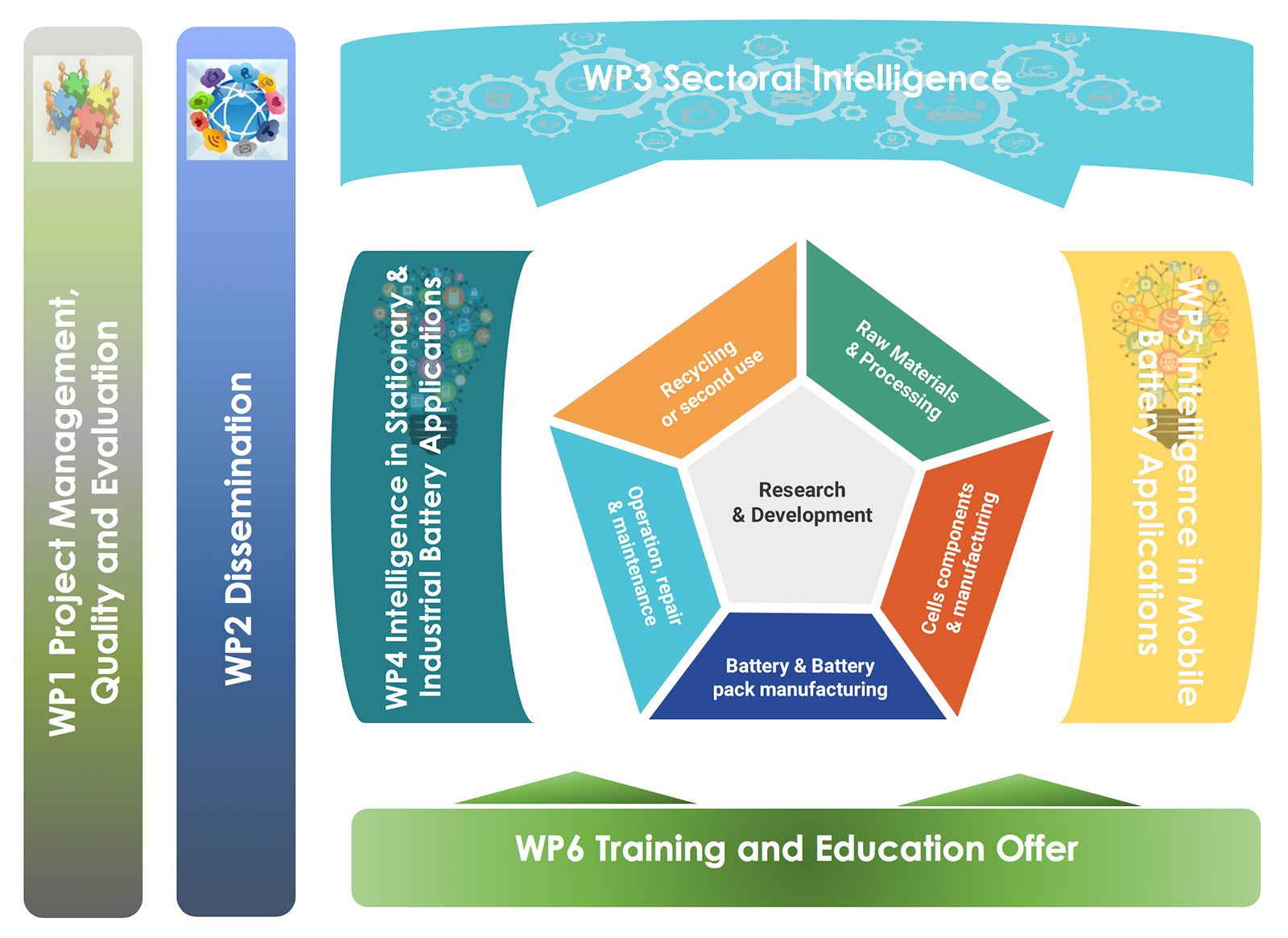results
This page gives an overview of the organisation of the work and interdependence of activities in ALBATTS. It provides details on the results and short and long-term expected impact.
Click here to access the full list of deliverables.

Short term impact:
-
Analysis of the overall battery sector on its strengths and weaknesses. Including its interconnections with individual sub-sectors (stationary and other industrial battery applications, mobile battery applications); the future direction of the sector viewed through the evolution of technology; future skills need, recycling and second use.
-
Involving all levels of stakeholders in the sector, along the value chain (raw materials and processing, cell components and manufacturing, battery and battery pack manufacturing, recycling and second use - and all that horizontally supported in each step by research and development).
-
Training preparations based on the needs of the sector - including skills needs and needs of the methods used for the trainings.
-
Creation of knowledge and skills to start new VET and high degree programs within the sector, to supply the industry with skilled workforce.
-
Finally, development of knowledge and skills from VET providers' staff, by working together with companies and universities.
Long term impact:
-
The project will allow the development of new training programmes for the workforce already working in the battery sector, as well as to newcomers.
-
Integration of new curricula and qualifications in the national frameworks.
-
The increased investment in this sector will impact the expected number of new students.
-
Improvement of the image, status and attractiveness of VET schools participating.
-
The project will create a sustainable partnership in this emerging economic sector.
-
Finally, enabling EU-wide recognition of specific skills/job role achievements in the sectoral employment market in member countries. This will have direct impact on possible mobility of workers/future workers in the sector. Harmonisation of job role/skills definitions on EU level, under umbrella for recognition.
The tables below list the public deliverables in the different phases of work with the respective publication date.
Sectoral Intelligence
The project partnership consistently monitors developments in the battery sector with extended desk research and close contact with stakeholders through a series of workshops, interviews, or detailed online surveys This includes skills needs, new or emerging job roles, or drivers of change that form the emerging battery sector.
Sectoral Skills Strategy
Stemming from the sectoral intelligence along the project duration, ALBATTS partners define the strategy for the sectoral skills agenda - Sectoral Skills Strategy. It encompasses recommendations to assure efficient education and training in this emerging battery sector.
|
|
Title of result(s) (output(s) or outcome(s) |
Released |
|
SKILLS STRATEGY FOR THE BATTERY SECTOR |
11/2021 |
|
|
Q4/2022 |
||
|
Q4/2023 |
||
|
|
|
|
|
SKILLS INTELLIGENCE STATIONARY & INDUSTRIAL APPLICATIONS |
D4.5 - Sectoral Intelligence definition for sub-sector ISIBA - Release 1 |
09/2021 |
|
D4.8 - Sectoral Intelligence definition for sub-sector ISIBA - Release 2 |
Q3/2022 |
|
|
D4.11 - Sectoral Intelligence definition for sub-sector ISIBA – Final |
Q3/2023 |
|
|
|
|
|
|
SKILLS INTELLIGENCE IN MOBILE BATTERY APPLICATIONS |
D5.5 - Sectoral Intelligence definition for sub-sector IMBA - Release 1 |
08/2021 |
|
D5.8 - Sectoral Intelligence definition for sub-sector IMBA - Release 2 |
Q3/2022 |
|
|
D5.11 - Sectoral Intelligence definition for sub-sector IMBA - Final |
Q3/2023 |
|
|
|
|
|
Support with Education and Training
Following intelligence on the needed skills and job roles, ALBATTS partnership works on providing support to education and training for EQF3-8 levels. This involves detailed curricula, training materials and pilot training courses that can be used directly by the industry, the training providers or as material for training-the-trainers.
|
|
Title of result(s) (output(s) or outcome(s) |
Released |
|
TRAINING & EDUCATION OFFER
|
D6.1 - Report on State-of-Art of job roles and education in sector |
10/2020 |
|
12/2021 |
||
|
Q4/2023 |
||
|
Q4/2023 |
||
|
D6.5 - Report on creation of OER and connected adaptive learning logistics |
Q4/2023 |
|
|
D6.6 - Report on piloted, demo-ed and delivered courses or modules. |
Q4/2023 |
|
|
Q4/2023 |
||
|
D6.8 - Strategy for Education and Training in the Batteries for Electromobility Sector |
Q4/2023 |
|
|
|
|
|
ALBATTS Dissemination Measures
Partners are involved in the wide dissemination and promotion of the project’s activities towards supporting of the skills agenda in the Battery sector.
|
|
Title of result(s) (output(s) or outcome(s) |
Released |
|
DISSEMINATION
|
Q4/2023 |
|
|
Q4/2023 |
||
|
Q4/2023 |
||
|
Q4/2023 |
||
|
Q4/2023 |
||
|
|
|
|

